Shopify merchants are under growing pressure to track conversions accurately — while also complying with increasingly strict privacy rules.
But browser-based methods might fail when it matters most. Tracking scripts get blocked, UTMs are lost between sessions, and purchases show up as “Direct / None” instead of the actual campaign.
That’s where server-side tracking makes a difference. When used properly, it doesn’t just improve conversion accuracy — it helps Shopify merchants capture, store, and reuse high-quality first-party data that platforms like Meta, GA4, and TikTok rely on for attribution and optimization.
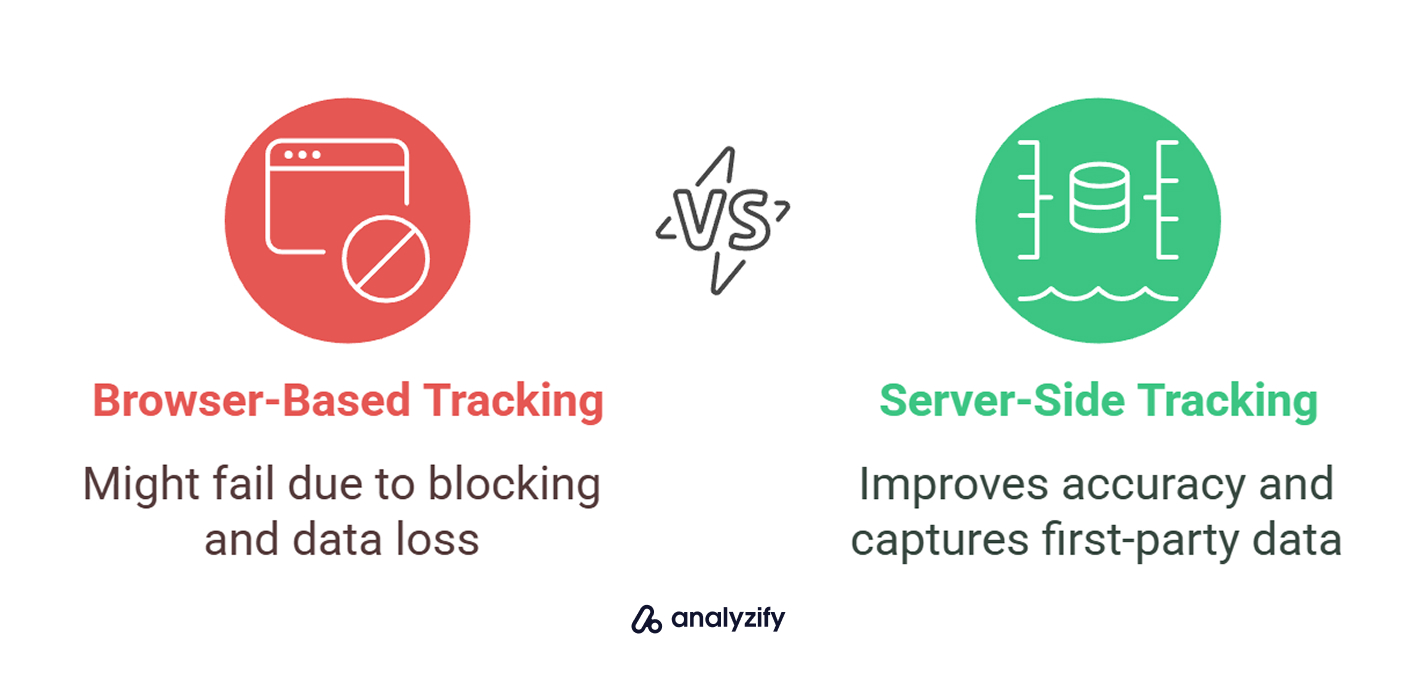
Here’s what this article covers:
✅ Why first-party data is now more valuable than third-party cookies or pixels
✅ How server-side tracking helps Shopify stores collect and retain first-party data
✅ What types of Shopify data can be stored (cart, order, customer layers)
✅ How this setup improves attribution, consent handling, and campaign performance
We’ll also cover specific use cases from Analyzify’s server-side tracking structure — showing how your store can send more accurate events, even when browser conditions fail.
Bonus: Explore our comprehensive Shopify Server-Side Tracking Guidebook covering implementation strategies, first-party data, and solutions for all tracking limitations.
What Is First-Party Data in Shopify — and Why Does It Matter?
First-party data refers to any information collected directly between your Shopify store and your visitors. Unlike third-party data, which relies on external cookies or ad platforms, first-party data is stored under your domain and is under your control.
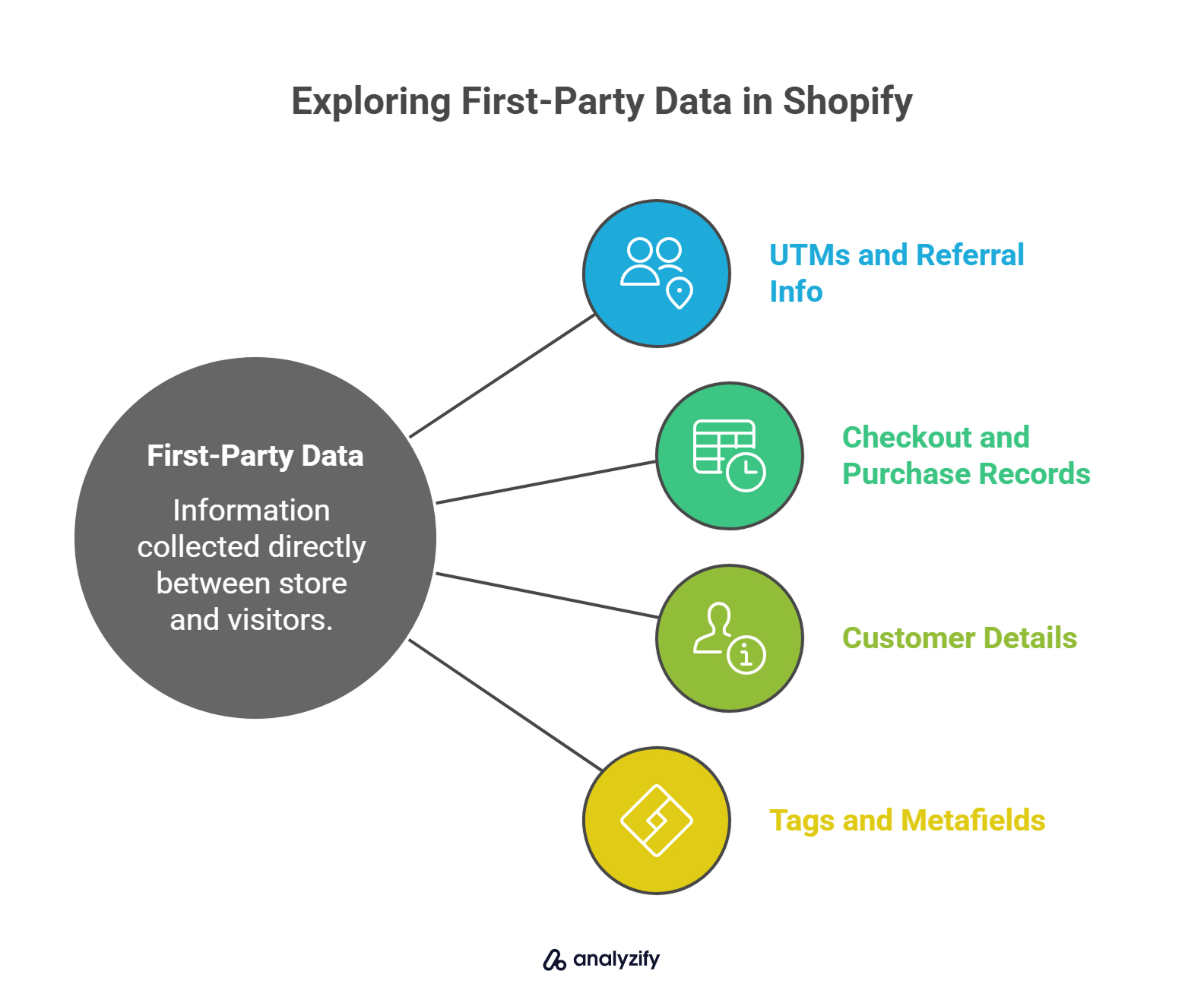
Examples of first-party data in Shopify include:
UTMs and referral info saved into the cart or order
Checkout and purchase records (order IDs, SKUs, coupon codes)
Customer details like email, phone number, acquisition source
Tags or metafields that describe session-level or behavioral signals
This type of data is more accurate because it reflects real customer actions on your store — not modeled assumptions from third-party scripts.
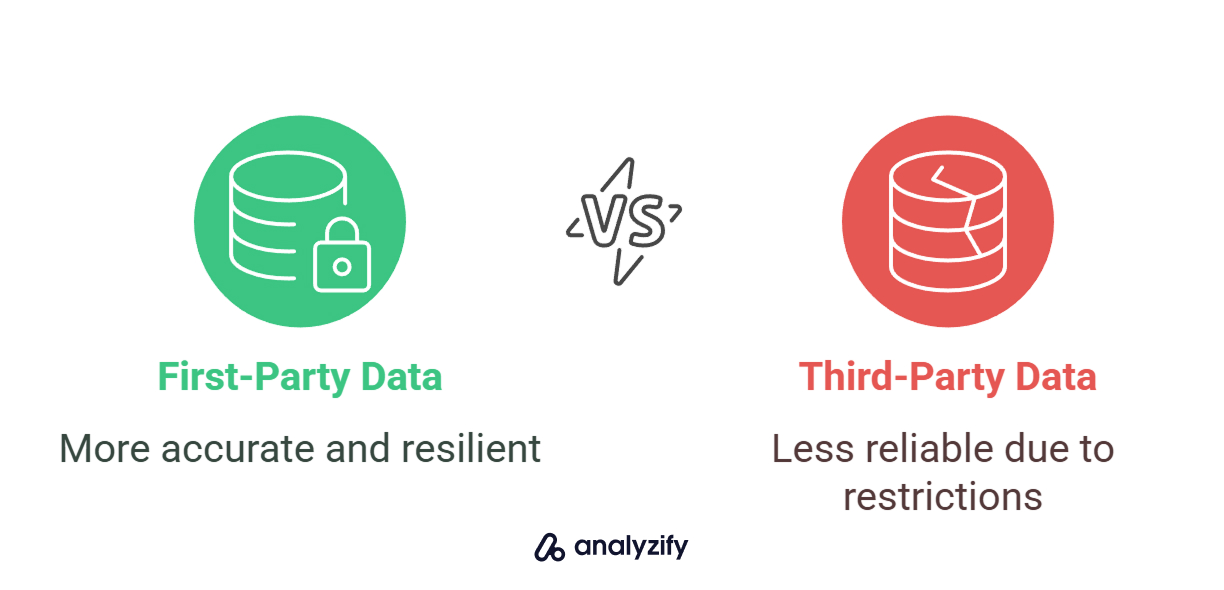
But most importantly, it’s resilient. Even if a browser blocks your tracking scripts or a user completes their purchase hours later on a different device, the first-party data stored in Shopify (e.g., cart notes or order metafields) can still be accessed and sent through platforms like Meta, GA4, or TikTok.
That’s why Shopify merchants are now treating first-party data as the most dependable layer in their tracking stack - especially as GDPR, iOS restrictions, and cookie loss make traditional methods less reliable
What Are the Limitations of First-Party Data Without Server-Side Tracking?
Shopify technically allows you to collect first-party data but without a proper system in place, most of it is either lost or incomplete. By default, Shopify doesn’t store UTM parameters, referral data, or session-level details beyond the current visit. That means even though the data is “first-party,” it quickly disappears unless you actively capture and store it.
![]()
The most common limitations include:
❌ UTMs are not stored unless captured manually — Shopify doesn’t persist them into orders or customer profiles out of the box.
❌ Data tied to anonymous sessions is lost easily — if a user returns later or uses another device, attribution breaks.
❌ Browser-side data depends on scripts that often fail — ad blockers, iOS settings, or checkout redirects can prevent tags from firing.
❌ No automatic enrichment — platforms like Meta and GA4 require contextual parameters (campaign, click ID, user identifiers), which Shopify doesn’t send natively.
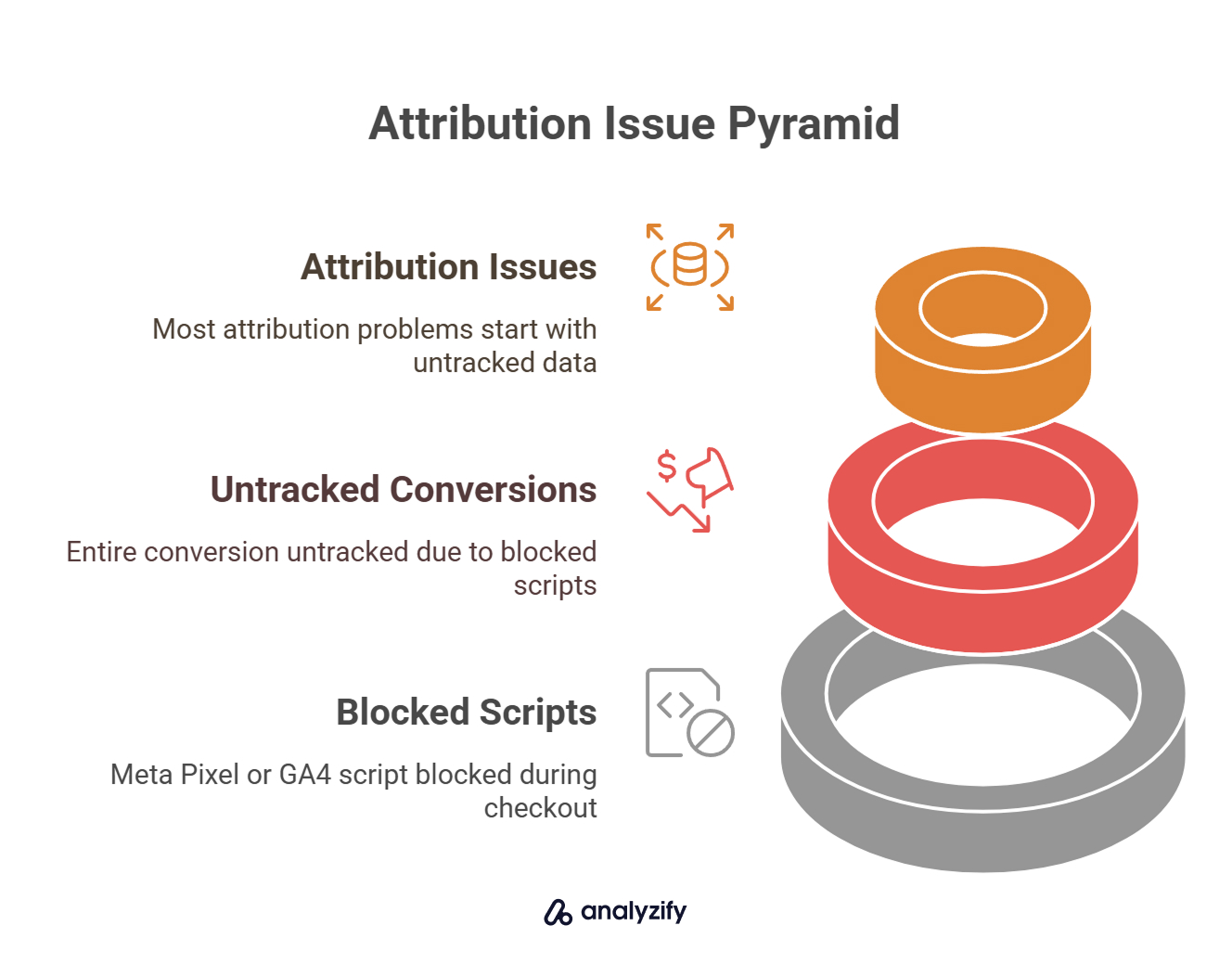
For example, a user might click a Meta ad, add a product to the cart, and complete the purchase an hour later — but the campaign data never reaches your analytics tools unless it was explicitly saved somewhere in Shopify.
And if the Meta Pixel or GA4 script was blocked during checkout, the entire conversion may go untracked, even though the customer paid. This is where most attribution issues start.
Bonus: Learn more about Why Your Attribution Data Doesn’t Match Across Platforms!
How Server-Side Tracking Strengthens First-Party Data in Shopify
Server-side tracking doesn’t just improve event delivery — it fills the gaps left by browser-side limitations and makes your first-party data more reliable, more complete, and more reusable across platforms.
Analyzify’s server-side setup reads from the data already stored in your Shopify store — even if the original session expired or the pixel failed. It captures, enriches, and sends that data to GA4, Meta, or TikTok using platform-specific APIs.
![]()
Here’s how Analyzify strengthens your first-party data:
✅ Captures and stores attribution data at the cart level — including UTMs, referrer, fbclid, and GA4 client ID, even for anonymous users
✅ Passes stored data into orders automatically — so final purchases contain campaign context even if completed hours later or on another device
✅ Enriches server-side events with stored values — Analyzify attaches UTMs, click IDs, customer emails, and more to each event sent to ad platforms
✅ Improves reliability when scripts are blocked — your purchase event still reaches GA4 or Meta, even if the browser fails entirely
 Built for Shopify - No Dev Work Required - Fast Setup
Built for Shopify - No Dev Work Required - Fast Setup 
Missing Conversions in GA4 or Meta Ads?
Standart browsing tracking misses conversions - Analyzify adds Server-side tracking for accurate GA4 & Meta reports.This layered structure makes first-party data not only more durable, but also actionable. You don’t just store the data, you actively use it to power campaign attribution, audience segmentation, and performance tracking across all key platforms,
Bonus: Learn the key benefits of GA4 server-side tracking for Shopify stores
What Types of Shopify Data Can Be Stored and Used as First-Party?
First-party data only becomes useful when it’s stored consistently and Shopify provides three key layers where attribution and customer information can be captured. Each of these layers supports different use cases, from short-term campaign tracking to long-term customer insights.
Analyzify uses all three layers to build a complete, stable, and reusable first-party data structure.
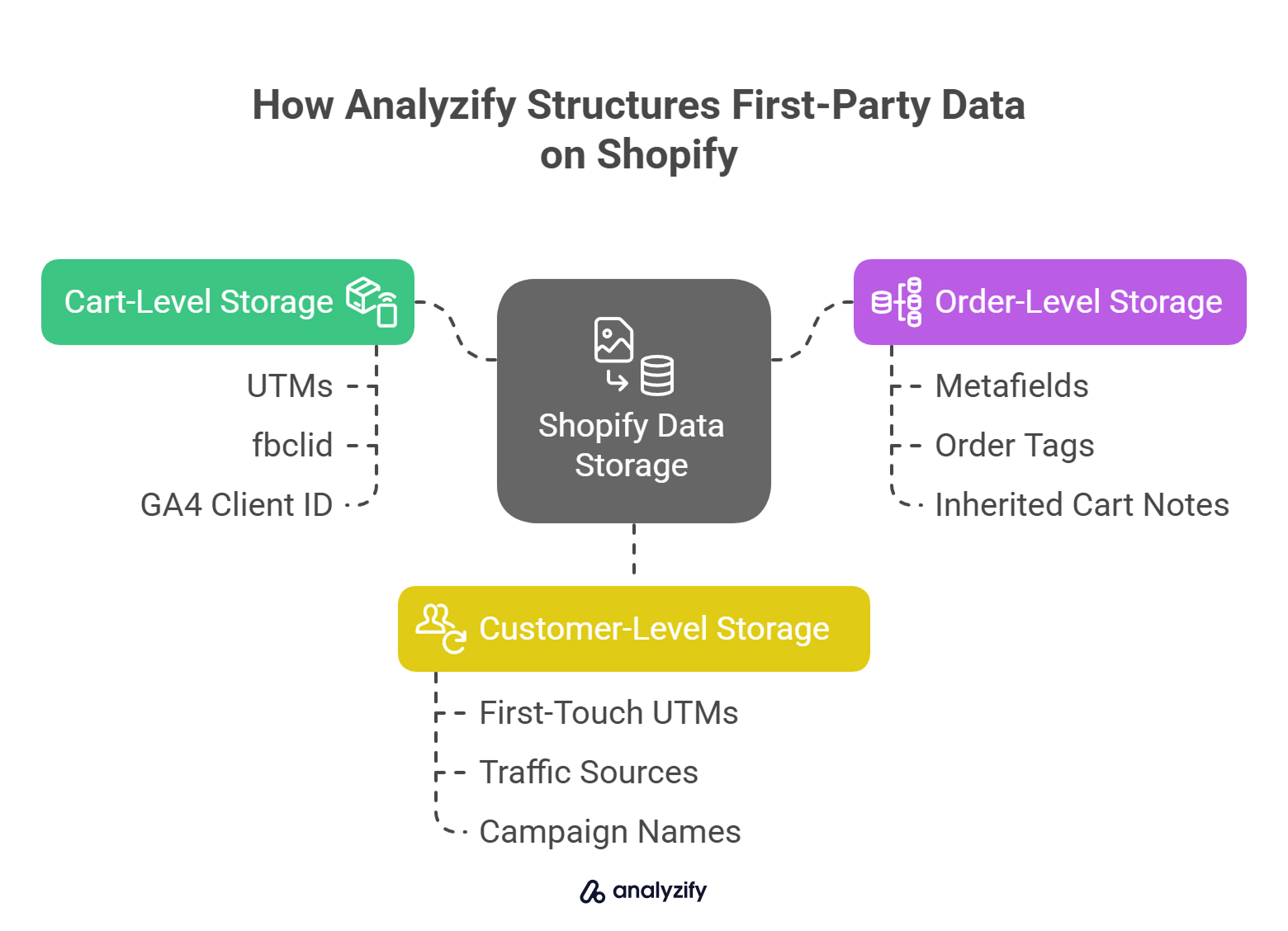
Cart-Level Storage: Capturing Attribution Data Early
The cart is the first point where Shopify allows data to be stored — as soon as a product is added.
Analyzify stores UTMs, fbclid, GA4 client ID, and referrer info in cart attributes or notes
No login is required. This works for anonymous users as well
Cart data stays persistent even if the purchase happens hours later or on a different device
Order-Level Storage: Passing Attribution Into Final Purchase Data
Once the purchase is complete, cart-level data is carried into the order itself.
Shopify allows you to store attribution in metafields, order tags, or inherited cart notes
This data becomes the foundation for server-side event enrichment
Analyzify reads it to send complete, campaign-aware events to Meta, GA4, and TikTok
Why Is Event Enrichment Critical for Accurate Attribution?
Ad platforms like Meta, Google, and TikTok don’t just need a purchase signal, they need context. Without key parameters like UTMs, click IDs, or user identifiers, most conversions end up unattributed or misattributed. This is especially common on Shopify, where default tracking setups often fail to carry campaign data into the final order.
That’s where event enrichment becomes essential.
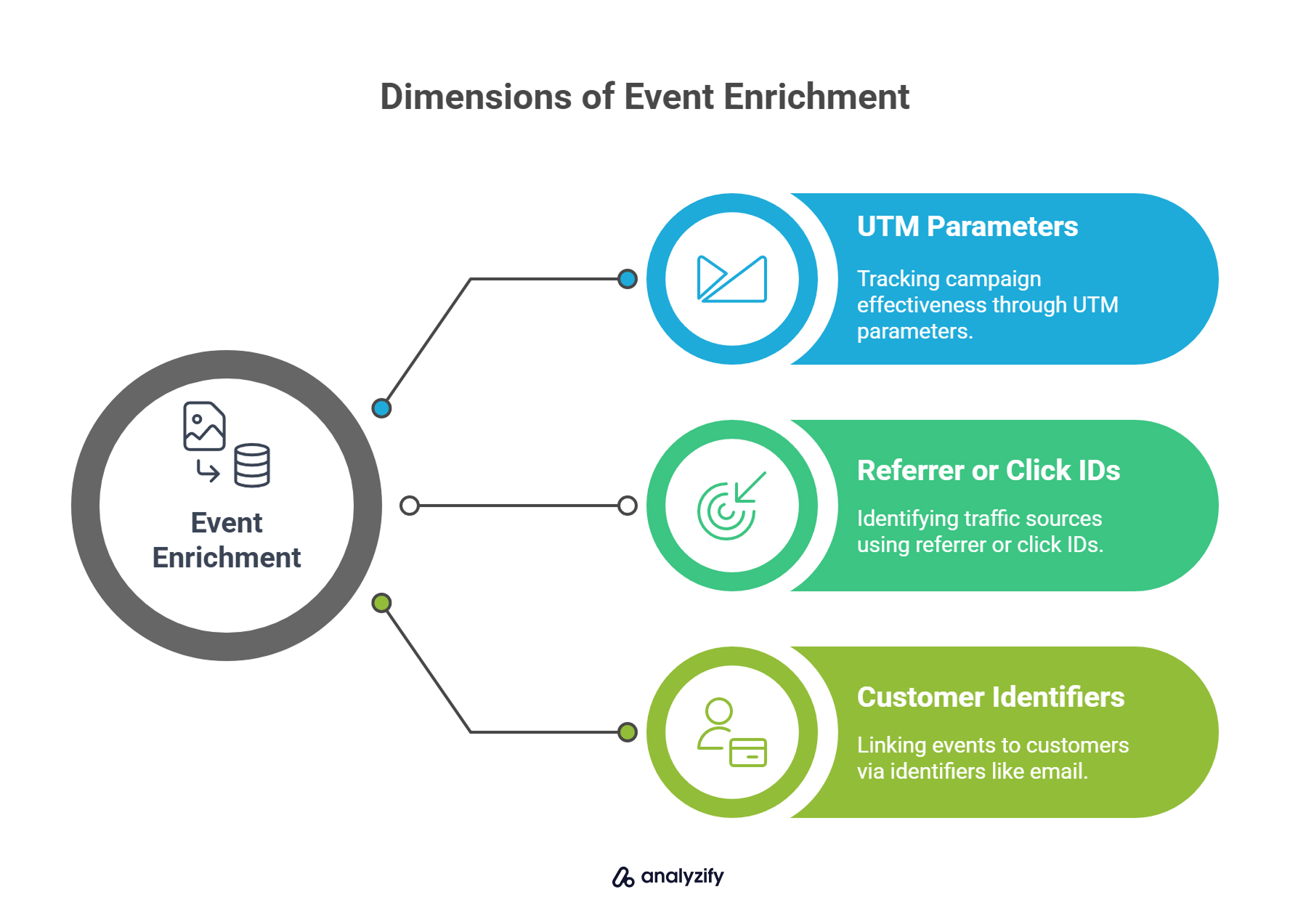
What is Event Enrichment?
Event enrichment means attaching additional data — such as:
UTM parameters
Referrer or click IDs (e.g. fbclid, gclid)
Customer identifiers (e.g. email, phone, external ID)
…to the event before sending it to a platform. This ensures that even if the browser didn’t fire the pixel, the server-side event still includes everything needed for attribution and optimization.
How Analyzify Enriches Events with First-Party Data
Analyzify applies a layered logic:
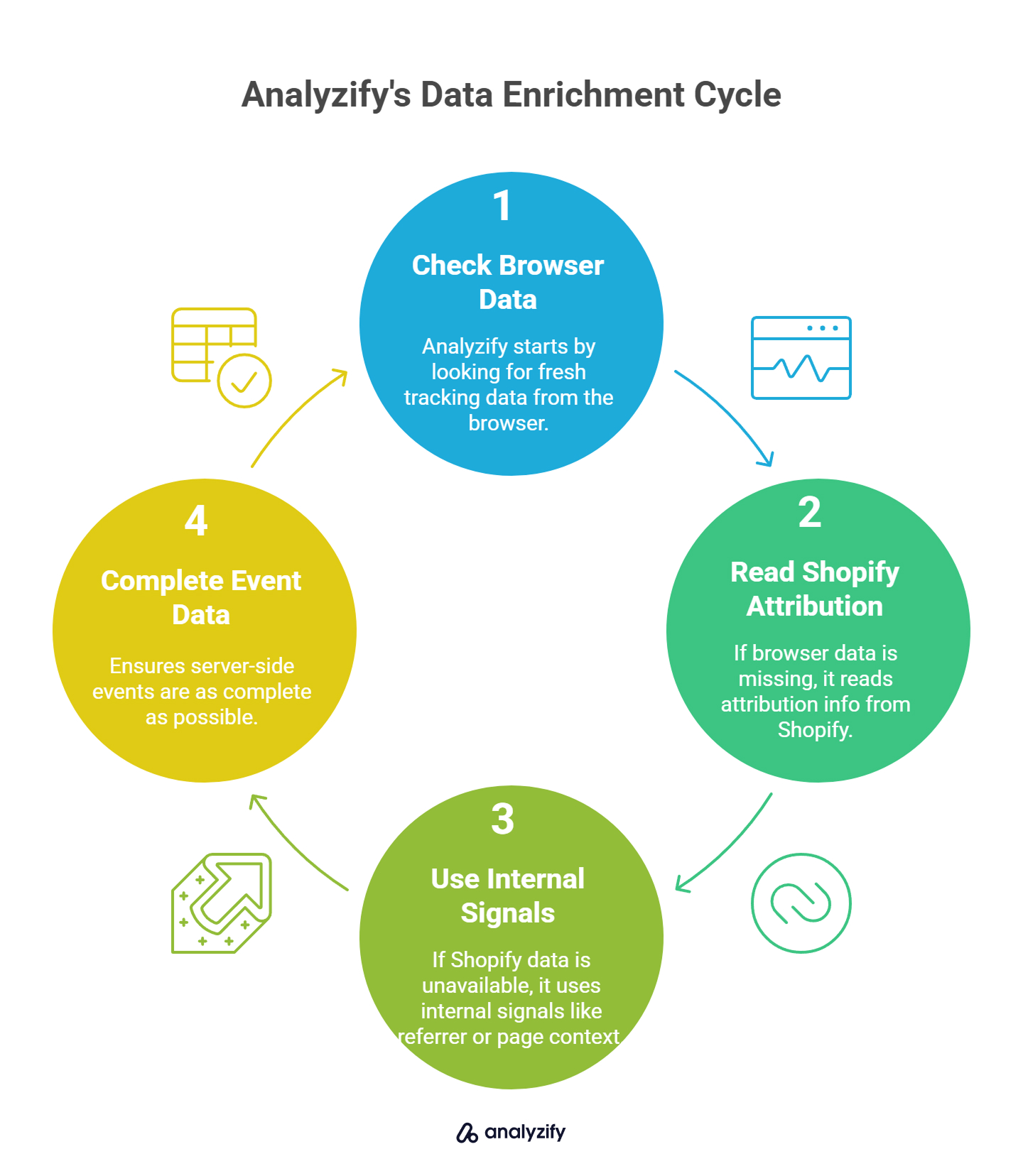
First, it looks for fresh tracking data from the browser (if available and consented)
If that’s missing, it reads attribution info stored in Shopify — cart notes, order tags, customer metafields
If none of those are available, it falls back to internal signals (like referrer or page context)
This means your server-side events are as complete as possible, even when browser tracking fails.
The Result: Higher Match Rates, Better Attribution
Platforms like Meta reward enriched events with higher Event Match Quality (EMQ) scores — improving both reporting accuracy and campaign performance. GA4, in turn, can properly match conversions back to sessions when the transaction ID and campaign context are included.
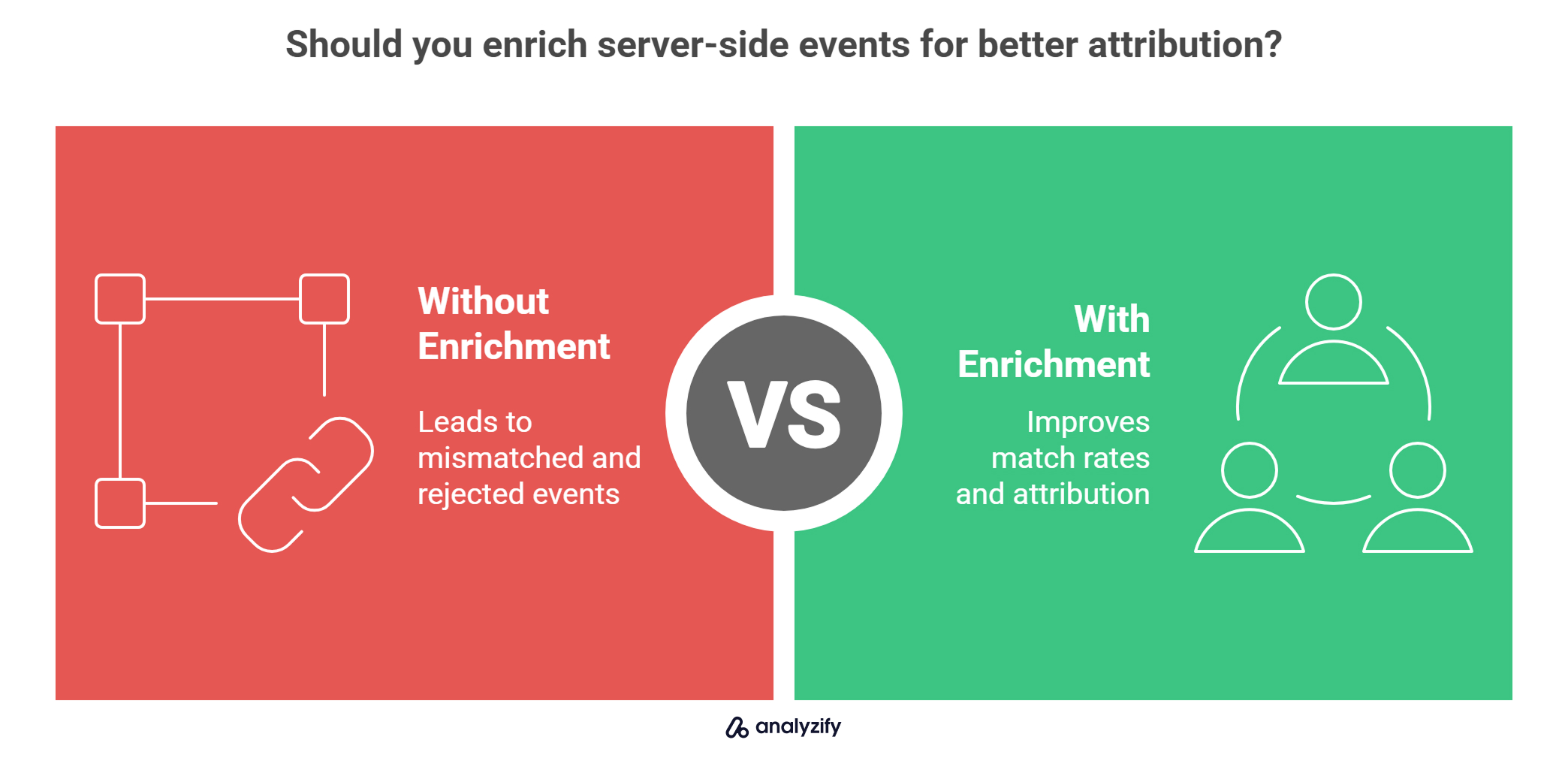
Without enrichment, server-side events are often:
Mismatched or unattributed
Rejected due to missing identifiers
Invisible to remarketing and reporting workflows
That’s why event enrichment isn’t optional — it’s what turns first-party data into real attribution power
 Built for Shopify - No Dev Work Required - Fast Setup
Built for Shopify - No Dev Work Required - Fast Setup 
Standart Tracking Methods Aren't Enough for Shopify
Let Analyzify combine client-side and server-side tracking. So you capture every important event, even when browser script fail.Is This Setup GDPR-Compliant?
Yes — but only if consent is handled correctly.
There’s a common misconception that server-side tracking operates outside the scope of privacy laws like GDPR. In reality, how the data is collected matters just as much as where it’s sent from. Server-side tracking still involves personal data — and platforms expect that consent has been granted before processing it.
How Consent Is Captured and Respected
Analyzify ensures GDPR compliance by integrating directly with:
Shopify’s Customer Privacy API — to retrieve user consent choices
Google Consent Mode (v2 - Advanced) — to align with GA4 and Google Ads consent requirements
This means:
Events are only sent when the proper level of consent is detected
Personal identifiers (e.g., email, phone, click ID) are included only when legally allowed
GA4 events can still be sent in modeled, privacy-safe form when users deny consent — but with marketing features disabled
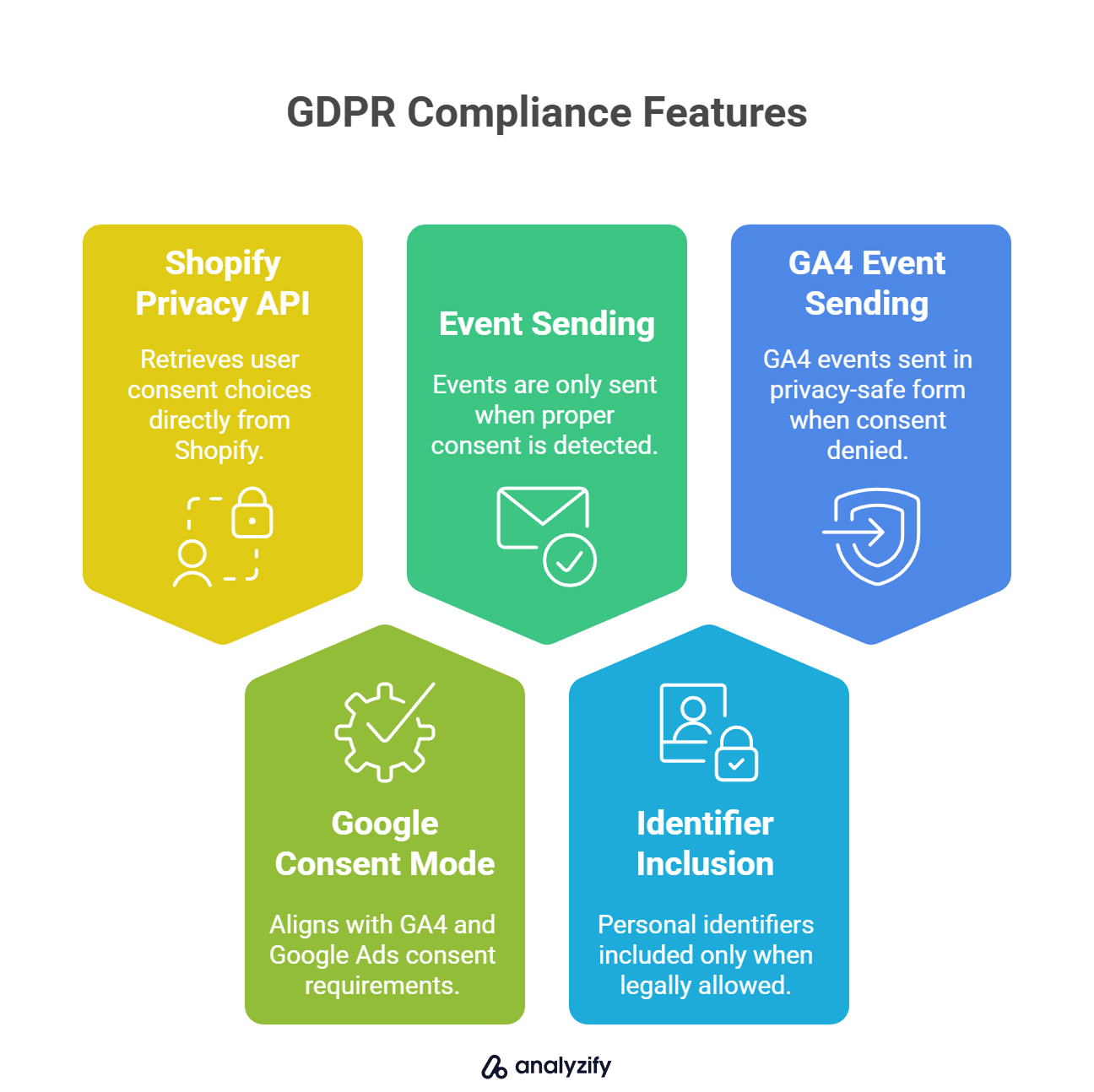
Why This Matters
Without a proper consent setup:
Platforms like Meta may reject your server-side events entirely
Google Ads remarketing will be disabled automatically
Your tracking setup may violate GDPR — even if you’re using server-side delivery
Bonus: Learn how server-side tracking works with GDPR for Shopify stores.
That’s why server-side tracking is not a workaround for privacy rules. It simply moves the delivery layer but still depends on what was captured in the browser, with consent.
Analyzify’s setup ensures your store stays compliant while maintaining as much tracking visibility as possible within legal boundaries
Can You Improve First-Party Data Without Server-Side Tracking?
Yes — but only to a limited extent.
Shopify does give merchants some tools to collect first-party data, like cart attributes, order metafields, and customer tags. And with custom development or manual tagging, you can capture UTMs or basic campaign data.
![]()
But without server-side tracking, your setup remains vulnerable to:
❌ Ad blockers and iOS restrictions — which prevent browser scripts from firing
❌ Session expiration — where attribution is lost if the purchase happens later or on another device
❌ Missing enrichment — platforms don’t get campaign or customer context unless it’s stored and sent reliably
❌ No fallback layer — if client-side tracking fails, the event is lost entirely
Even a technically sound client-side setup can still lead to attribution gaps, mismatched data, and underreported conversions — especially for anonymous or multi-device users.
Server-Side Tracking Fills These Gaps
By sending enriched purchase data directly from Shopify’s backend, Analyzify ensures that:

Attribution survives browser failures
Campaign data is stored and passed automatically
Events are sent with all necessary parameters — even without client-side scripts
That’s why server-side tracking isn’t just a “nice to have”, it’s now the only reliable way to preserve your first-party data and send accurate conversions across platforms.
Final Thoughts: First-Party Data Needs More Than Just Ownership
Storing your own data is important — but making it usable is what unlocks results. Server-side tracking gives Shopify merchants the missing layer: durable, consent-aware delivery of enriched events that platforms can actually work with.
If you’re optimizing Meta campaigns, fixing GA4 attribution gaps, or trying to capture every conversion accurately, first-party data and server-side tracking are now essential.
Analyzify’s server-side setup is designed specifically for Shopify — storing attribution data where it matters, and sending it where it counts.
 Built for Shopify - No Dev Work Required - Fast Setup
Built for Shopify - No Dev Work Required - Fast Setup 
Start Tracking Shopify Orders Accurately!
Let Analyzify's enhanced server-side tracking provide you with more accurate & reliable attribution data - setup in 10-15 minutes.Want to build a stronger data foundation for your store?
Our team can help you implement or upgrade your server-side tracking — fully aligned with consent rules, platform best practices, and your Shopify setup.
👉 [Learn more about Analyzify’s server-side tracking]
👉 Book a free demo to review your current tracking setup































